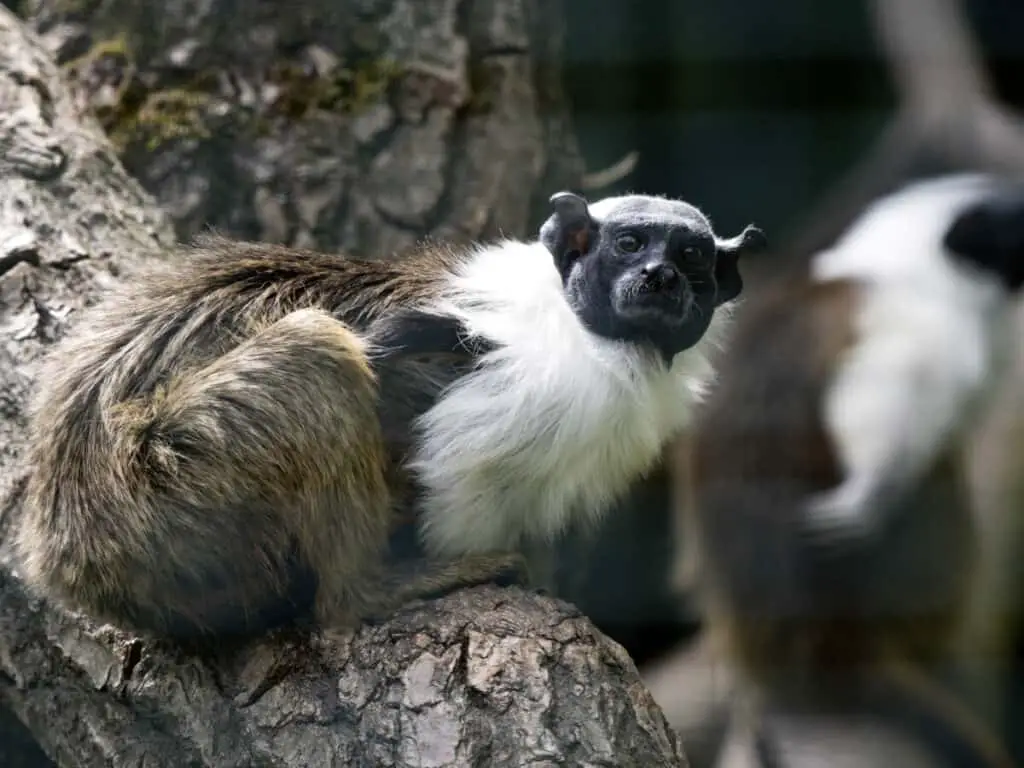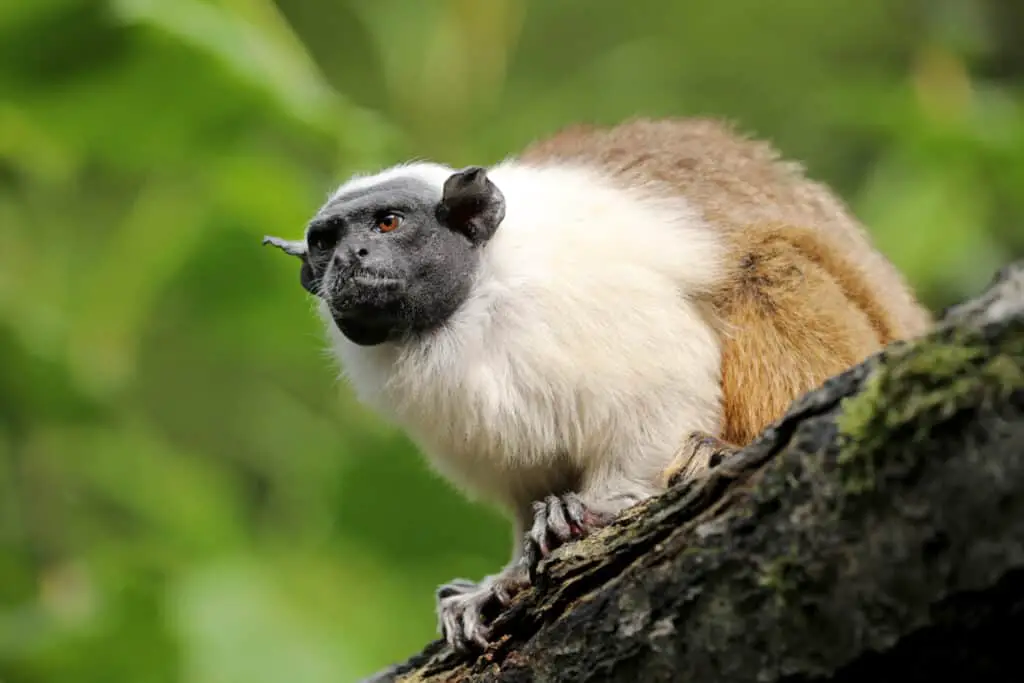The pied tamarin, also known as the Saguinus bicolor, is a small primate species that inhabits the Amazon rainforest in South America. These primates are part of the Callitrichidae family and are one of the smallest members of this group.
The pied tamarin has distinctive black and white markings on its fur, with a white forehead and cheeks, while the rest of their body is black.
Pied tamarins have been studied extensively due to their unique social behavior. They live in groups of six to nine individuals consisting of an alpha male and female pair who mate for life, along with several subordinate males and females.
This cooperative breeding system allows for increased survival rates for offspring as all members take care of young. Additionally, these primates often participate in mutual grooming which strengthens social bonds within the group.
Despite being a relatively common sight in some parts of the Amazon forest, habitat destruction caused by human activity continues to threaten their population numbers.

Physical Characteristics Of The Pied Tamarin
The Pied Tamarin, also known as Saguinus bicolor, is a small primate that belongs to the Callitrichidae family. It is found in Brazil’s Amazon Basin and inhabits primary and secondary forests.
The species exhibits sexual dimorphism whereby males are slightly larger than females; they weigh between 400-450g while females weigh around 350g. The Pied Tamarin has a unique characteristic where it possesses long white hairs on its forehead, giving it an appearance of having eyebrows.
Fun facts about this species include their ability to produce twins or triplets during breeding season. They have evolved numerous adaptations for survival in their natural habitat, including being able to move quickly through trees using their prehensile tails for balance.
Additionally, they possess sharp claws and teeth used for hunting insects, which make up most of their diet. These features allow them to be efficient predators in the forest canopy, where they spend most of their time searching for food.
Habitat And Distribution Of The Pied Tamarin
Having discussed the physical characteristics of the pied tamarin, it is now essential to delve into its habitat and distribution.
The pied tamarin is native to the tropical rainforests of the Amazon Basin, which spans across nine different countries in South America.
These primates are arboreal creatures, meaning they spend most of their time high up in trees, which provide them with safety from predators on the ground.
The pied tamarin prefers primary forests that contain an abundance of tall trees as well as secondary forests consisting of younger growths. They can also be found in flooded forests during times when water levels rise significantly.
However, due to deforestation caused by human activities such as logging and agriculture, these monkeys have experienced a significant decline in numbers over recent years.
As a result, conservation efforts have been put in place to protect this species and prevent further destruction of their natural habitats.
Family Callitrichidae: The Miniature Wonders of Callitrichids
3 Ways Deforestation Affects Pied Tamarins:
- Loss of Habitat: With large areas being cleared for farming or other uses, pied tamarins lose access to food sources and shelter.
- Fragmentation: When forests are fragmented into smaller isolated patches, populations become more vulnerable to genetic issues and disease outbreaks.
- Human Conflict: As humans move closer into forested areas occupied by pied tamarins there may be increased likelihood of conflict between people and wildlife.
Social Behavior And Communication
Pied tamarins are highly social primates that live in groups of up to 12 individuals. Within these groups, a dominance hierarchy is established through competition for resources such as food and mates. This hierarchy determines the access each individual has to these resources and also influences their behavior towards others in the group. Dominance is typically determined by body size, strength, and aggression levels, with dominant individuals having priority over subordinate ones.
Communication among pied tamarins primarily consists of vocalizations and body language. They use various calls to communicate different types of information including alarm calls, contact calls, and territorial calls. In addition to vocalizations, they also use physical gestures such as tail movements, facial expressions, and postures to convey messages.
These signals play an important role in maintaining social relationships within the group and avoiding conflicts between individuals. Overall, communication plays a vital role in the social dynamics of pied tamarin groups and helps them navigate complex interactions with one another.
Reproduction And Parenting
Social behavior and communication are crucial aspects of the pied tamarin’s life. These primates are highly social animals that live in groups of up to 15 individuals, which include both males and females. Within these groups, a strict hierarchy exists, with dominant pairs occupying the highest rank. Pied tamarins communicate through various vocalizations and body language signals such as tail-flicking, grooming, and physical contact.
Breeding habits among pied tamarins involve monogamous pairings where only one breeding male and female exist within each group. The mating season typically occurs between November and April when food is more abundant. Gestation lasts for approximately 140 days, after which the female gives birth to twins or occasionally triplets.
Infant care is shared among all members of the group, but primarily falls on the mother’s shoulders during their early stages of development. Both parents participate in carrying the infants from one location to another while other group members groom them regularly.
Pied tamarin communities demonstrate remarkable parenting skills by providing extensive infant care support systems necessary for successful offspring rearing. Group members besides biological parents often assist in caring for young ones by playing critical roles like protecting them from predators or participating in feeding activities. As they mature into adults themselves they form new families repeating this cycle ensuring continued survival of future generations across generations without fail.
Threats To The Pied Tamarin Population
Like a beacon of hope in the midst of dense forests, the pied tamarin swings from tree to tree with grace and agility. Unfortunately, its population is threatened due to various factors such as human encroachment and hunting pressure.
Human encroachment poses a major threat to the habitat of pied tamarins. As humans continue to expand their settlements into areas that were once forested, they are destroying the natural habitats of these primates. This destruction leads to fragmentation of forests which disrupts foraging patterns, mating behaviors, and gene flow among populations.
Hunting pressure also contributes significantly to reducing the number of pied tamarins in their native environment. Despite being protected by law in some countries, illegal hunting still persists due to cultural beliefs and practices surrounding bushmeat consumption or pet trade.
These threats must be addressed urgently if we want future generations to appreciate the beauty and value of this species.

Conservation Efforts And Future Outlook For The Pied Tamarin
Conservation efforts for the pied tamarin have been ongoing, with various organizations and local communities working together to protect the species. One such effort is through eco-tourism, where visitors can observe the tamarins in their natural habitat while also contributing to conservation efforts. By providing an alternative source of income for local communities, it helps decrease reliance on activities that may harm or disturb the tamarins’ habitat.
Another crucial aspect of conservation involves community involvement. Local communities are essential stakeholders in protecting the pied tamarin as they live alongside them and understand their behavior patterns better than anyone else. Involving them in conservation education programs can help raise awareness about the importance of preserving these primates’ habitats and encourage sustainable practices that benefit both humans and wildlife. Through collaborative efforts between different stakeholders, there is hope that this charismatic primate will continue to thrive in its native range.
| Column 1 | Column 2 | Column 3 |
|---|---|---|
| Challenges faced by Pied Tamarins | Current Conservation Efforts | Future Outlook |
| Habitat loss due to deforestation and urbanization | Eco-tourism initiatives aimed at promoting responsible tourism while generating funds for conservation projects | Increase community participation in conservation efforts |
| Hunting and illegal pet trade activity | Reforestation projects aimed at restoring degraded habitats and increasing connectivity between fragmented forest patches | Develop a long-term plan for monitoring population trends and mitigating threats |
The table above summarizes some challenges faced by pied tamarins, current conservation efforts being implemented, and future outlooks towards ensuring their survival. Efforts like eco-tourism provide vital support for funding necessary research needed to develop more effective strategies against existing threats.
Additionally, incorporating reforestation projects into these efforts aims at restoring degraded habitats while increasing connectivity between fragmented forest patches – thus helping establish stable populations across wider areas of land. Ultimately, if we work collaboratively among all stakeholders involved in conservation efforts, we can ensure a brighter future for the pied tamarin.
Conclusion
The pied tamarin, a small New World monkey native to the Amazon rainforest of Brazil, is facing numerous threats that are leading to its declining population. Despite being a protected species, habitat fragmentation and destruction due to human activities have caused significant damage to their natural habitats.
The pied tamarin has unique physical characteristics, social behavior patterns, and communication methods that make it an interesting subject for research.
Efforts towards conservation of this endangered species include awareness campaigns aimed at educating locals about the importance of preserving these primates’ habitats. Additionally, breeding programs in captive environments aim to increase their numbers while protecting them from predators. However, climate change continues to pose a threat as deforestation increases worldwide.
A hypothetical example would be if 50% of the remaining wild populations were lost within 10 years; conservational endeavors might become futile without urgent action taken by governments and organizations supporting environmental protection.
In conclusion, saving the pied tamarin from extinction requires collaborative efforts between local communities, NGOs, and government agencies. Actions such as reforestation programs could help restore crucial habitats while providing sustainable livelihoods for people living around these forests.
Ultimately, success will depend on how committed stakeholders are in promoting policies that support biodiversity preservation while balancing economic development needs with environmental sustainability goals. Failure to act now may result in irreversible losses not only for the pied tamarin but also other threatened species sharing similar ecosystems globally.
